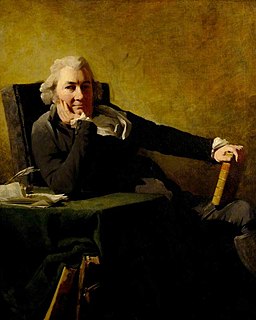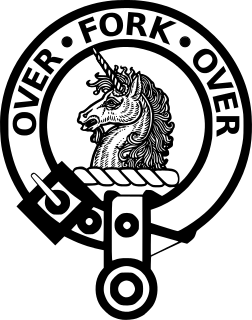Related Research Articles

Robert Bontine Cunninghame Graham was a Scottish politician, writer, journalist and adventurer. He was a Liberal Party Member of Parliament (MP); the first ever socialist member of the Parliament of the United Kingdom; a founder, and the first president, of the Scottish Labour Party; a founder of the National Party of Scotland in 1928; and the first president of the Scottish National Party in 1934.

Menteith or Monteith, a district of south Perthshire, Scotland, roughly comprises the territory between the Teith and the Forth. Earlier forms of its name include Meneted, Maneteth and Meneteth.

Earl of Airth was a title in the Peerage of Scotland, created on 21 January 1633 by Charles I, for William Graham, 7th Earl of Menteith. It became extinct on the death of his grandson in 1694.

The Mormaer or Earl of Menteith was the ruler of the province of Menteith in the Middle Ages. The first mormaer is usually regarded as Gille Críst, simply because he is the earliest on record. The title was held in a continuous line from Gille Críst until Muireadhach IV, although the male line was broken on two occasions. A truncated version of the earldom was given two years later to Malise Graham, 1st Earl of Menteith, in compensation for loss of the Earldom of Strathearn, which was a likely result of the execution of the Duke of Albany.

Robert Graham, who took the name Bontine in 1770 and Cunninghame Graham in 1796, was a Scottish politician and poet. He is now remembered for a poem If doughty deeds my lady please, which was later set to music by his great-great-grandson, Rev. Malise Cunninghame Graham and also by Sir Arthur Sullivan.

The Lords of the Congregation, originally styling themselves "the Faithful", were a group of Protestant Scottish nobles who in the mid-16th century favoured a reformation of the Catholic church according to Protestant principles and a Scottish-English alliance.

William Graham, 7th Earl of Menteith, 1st Earl of Airth, was a 17th-century Scottish nobleman. A supporter of King Charles I, he held offices including Lord President of the Court of Session and was a Privy Counsellor. Although he fell from favour, he continued to support the Royal cause during the Wars of the Three Kingdoms, when his estates were damaged by the troops of Oliver Cromwell. He married Agnes, daughter of Patrick, Lord Gray, and had a son John Graham, Lord of Kinpont, who had a son William Graham, 8th Earl of Menteith who prior to his death was styled William Graham, Lord of Kinpont.

William Cunningham, 9th Earl of Glencairn (1610–1664), was a Scottish nobleman, Lord Chancellor of Scotland, and a cavalier. He was also the chief of Clan Cunningham.

Inchmahome Priory is situated on Inchmahome, the largest of three islands in the centre of the Lake of Menteith, close to Aberfoyle, Scotland.

Kilmaurs is a village in East Ayrshire, Scotland which lies just outside of the largest settlement in East Ayrshire, Kilmarnock. It lies on the Carmel Water, 21 miles southwest of Glasgow. Population recorded for the village in the 2001 Census recorded 2,601 people resided in the village It was in the Civil Parish of Kilmaurs.

Clan Cunningham is a Scottish clan. The traditional origins of the clan are placed in the 12th century. However, the first contemporary record of the clan chiefs is in the thirteenth century. The chiefs of the Clan Cunningham supported Robert the Bruce during the Wars of Scottish Independence. In the 15th and 16th centuries, the Clan Cunningham feuded with the Clan Montgomery. Historically, the chief of Clan Cunningham held the title of Earl of Glencairn. However, in modern times the chief of the clan is Cunningham of Corsehill. On 18 December 2013, Sir John Christopher Foggo Montgomery Cunninghame, Baronet of Corsehill, was recognized by Lord Lyon as Clan Chief after the chiefship had been vacant for over 200 years.

Clan Montgomery is a Scottish clan of the Scottish Lowlands.
Malise Graham, 1st Earl of Menteith was a 15th-century Scottish magnate, who was the heir to the Scottish throne between 1437 and 1451, if Elizabeth Mure's children were not counted as lawful heirs.
Margaret Graham, Countess of Menteith was a Scottish noblewoman. She held the title Countess of Menteith in her own right, having inherited the title c. 1360 from her mother, Mary, Countess of Menteith, who was married to Sir John Graham. Graham was styled Earl of Menteith during his marriage with Mary, whom he predeceased. The Menteith region was situated partially in southwest Perthshire and partly in Stirlingshire.
Mary II, Countess of Menteith was a Scottish noblewoman. Her father was Alan II, Earl of Menteith, who died c. 1330. She is believed to have agreed with her kinsman Muireadhach III, in 1330, that he should hold the Earldom, but when he was killed in August 1332, Mary assumed the title. She married Sir John Graham, who in her right became Earl of Monteith and assumed the title in May 1346. She died sometime prior to 29 April 1360. She was the mother of Margaret Graham, Countess of Menteith.
Glencairn's rising was a Royalist revolt in Scotland against the Protectorate of Oliver Cromwell from 1653 to 1654. It was led by William Cunningham, 9th Earl of Glencairn (1610–1664), who was given command of the Royalist forces in Scotland by Charles II. Initially successful it began to suffer divisions when John Middleton arrived to replace Glencairn as commander, resulting in a series of duels between officers. It was defeated when Thomas Morgan caught Middleton's army at Dalnaspidal on 19 July 1654. Although the rising was unsuccessful it forced a change of policy by the Cromwellian regime, which now looked for a reconciliation with former Royalists and Engagers.
Alexander Graham, 2nd Earl of Menteith was a Scottish magnate.
William Graham, 8th Earl of Menteith, 2nd Earl of Airth, was a Scottish nobleman. He was active in the suppression of the Covenanters, but struggled with the burden of debts on his estates. On his death in 1694 his titles became extinct.
Sir Robert Graham of Kinpont was a Scottish landowner, and one of the key conspirators in the assassination of King James I of Scotland in 1437.
Alan II, Earl of Menteith was a Scottish Nobleman.
References
- 1 2 Frasier, William (1869). The chiefs of Colquhoun and their Country. p. 205.
- ↑ "Duchray Water". www.ainmean-aite.scot. Retrieved 24 September 2022.
- ↑ Disproving Crawfurd The Scots Peerage
- ↑ Papers of the Cunninghame Graham Family of Ardoch, Dunbartonshire. GB-234 GD22/3/422 National Archives of Scotland: Papers of the Cunninghame Graham Family of Ardoch including Legal and Financial documents, Letters and Personal papers, Title deeds and Estate papers, Documents relating to the Earls of Airth and Menteith and other miscellaneous items. 1646.
{{cite book}}: CS1 maint: location (link) - ↑ Papers of the Cunninghame Graham Family of Ardoch, Dunbartonshire. GB-234 GD/22/1/34 National Archives of Scotland: Papers of the Cunninghame Graham Family of Ardoch including Legal and Financial documents, Letters and Personal papers, Title deeds and Estate papers, Papers relative to the Earls of Airth and Menteith and other miscellaneous items.
{{cite book}}: CS1 maint: location (link) - ↑ Redbook of Menteith.
- ↑ Redbook of Menteith.
- ↑ Scott, Walter (1909). The Military Memories of John Gwynne and an account of the Earl of Glencairn's Expedition in 1653 and 1654. Hurst, Robinson, and Co. London. pp. 157–158.
- ↑ Graham, Rev. Patrick. Sketches of Perthshire. James Ballantyne and Co. pp. 183–184.
- ↑ Graham, Rev. Patrick (1812). Sketches of Perthshire. James Ballantyne and Co. pp. 183–184.
- ↑ FIRTH, CH (1899). Scotland and the Protectorate. pp. 291–293.
- ↑ Redbook of Menteith. p. 159.
- ↑ Papers of the Cunninghame Graham Family of Ardoch, Dunbartonshire. National Archives of Scotland: Papers of the Cunninghame Graham Family of Ardoch including Legal and Financial documents, Letters and Personal papers, Title deeds and Estate papers, Papers relative to the Earls of Airth and Menteith and other miscellaneous items. 1668.
- ↑ Chambers, Robert (1874). Domestic Annals of Scotland, from the Reformation to the Revolution. W. &. R. Chambers, Edinburgh.
- ↑ "Papers of the Cunninghame Graham Family of Ardoch, Dunbartonshire". Papers of the Cunninghame Graham Family of Ardoch including Legal and Financial documents, Letters and Personal papers, Title deeds and Estate papers, Papers relative to the Earls of Airth and Menteith and other miscellaneous items. GB-234 - GD/22/1/30 National Archives of Scotland.
{{cite web}}: Missing or empty|url=(help) - ↑ Dobson, David (2003). Directory of Scots Banished to the American Plantations, 1650-1775. Clearfield. p. 61.
- ↑ Transactions of the Hawick Archeological Society. James Haining and Co. 1863.
- ↑ Redbook of Menteith. 439.
{{cite book}}: CS1 maint: location (link) - ↑ Stewart, William J. (2012). Collins dictionary of law (3rd ed.). Glasgow [Scotland]: Collins. ISBN 9780007221653., the money that the vassal had to pay to his superior